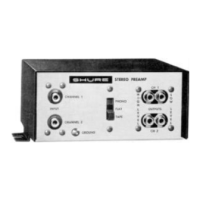
Do you have a question about the Shure M64 and is the answer not in the manual?
Lists common uses like converting record players, preamplifying microphones, and extending cable lengths.
Highlights benefits such as low noise, freedom from microphonics, and long output cable use.
Explains the difference between M64 and M64-2E voltage operation and switch functionality.
Details gain levels for 1 kHz input at High Level and Low Level outputs for different equalization settings.
Defines frequency response for Flat, Phono (RIAA), and Tape (NAB) settings.
Specifies total harmonic distortion limits at 1 kHz and at 30 Hz for Phono position.
Lists minimum input clipping levels at 1 kHz for Flat, Phono, and Tape positions.
States channel separation is 50 dB or better at 1 kHz.
Indicates channel balance is matched within 2 dB at 1 kHz.
Specifies noise levels for Phono and Flat settings, measured below 10 millivolt input.
Details the 120V AC (±10%) or 30V DC (±20%) for M64 and 240V AC (±10%) for M64-2E.
Explains powering the unit with batteries or external supplies, noting battery life and options.
Specifies input impedance and output impedance for High Level and Low Level outputs.
Covers dimensions, weight, power consumption, and temperature range for operation and storage.
Provides guidance on placement, avoiding hum sources, and connecting grounding wires.
Warns about shock hazard when used with transformerless (ac-dc) amplifiers and recommends isolation transformers.
Details selector switch use, connecting signal leads for Phono/Tape/Flat, and output connections.
Describes how to modify the unit for professional low-impedance balanced line use, including gain adjustment.
Outlines the warranty coverage, liability limitations, and return procedure for defective units.
Presents the detailed schematic diagram for the Model M64 stereo preamplifier.
Presents the detailed schematic diagram for the Model M64-2E stereo preamplifier.
Shows the physical layout of components on the printed circuit board for reference.
Lists Shure part numbers and descriptions for components used in the preamplifier assembly.
